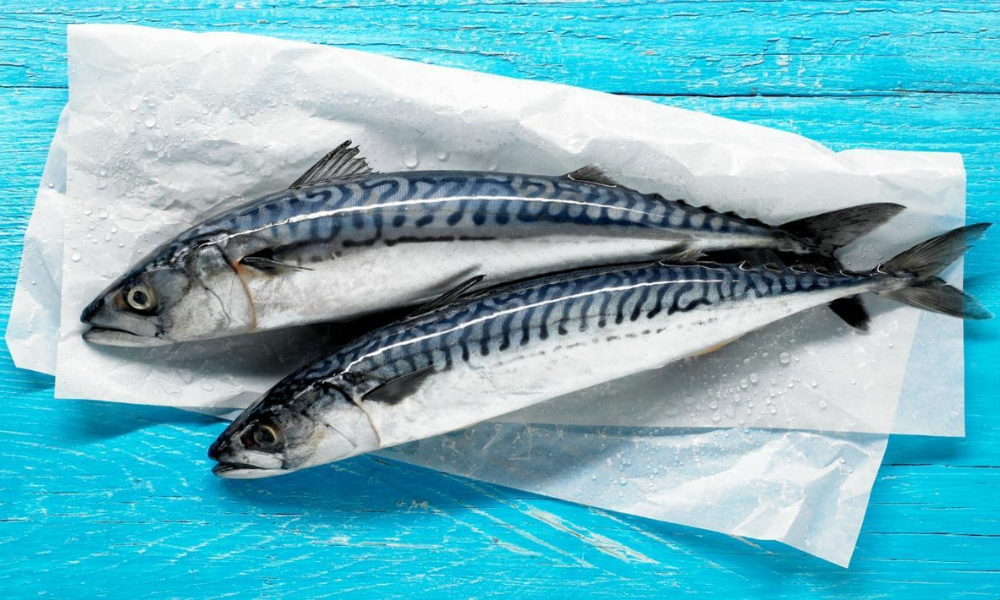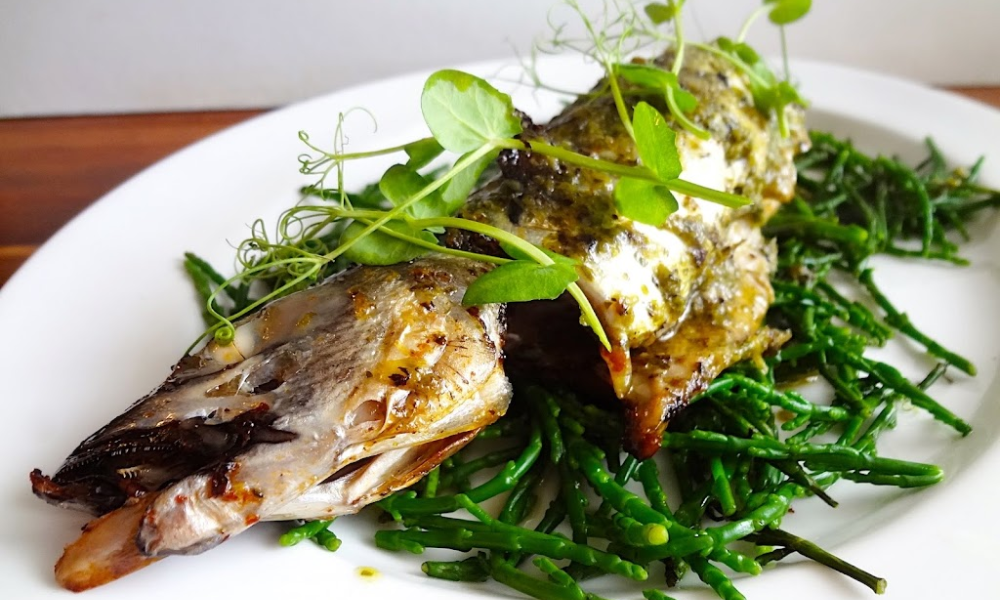Mackerel is a saltwater fish that is a favourite among people who eat it. It is a member of the Scombridae family. Mackerels have stripes on their backs and a greenish-blue colour. They have stunning silver bellies. With a deep fork in their tails, these fish are particularly recognisable. Pelagic fish in this family can be found in both tropical and arctic waters. In essence, they are drawn to the ocean’s offshore coast.
Mackerels have a significant role in commercial human meals. Each year, up to 8 million tonnes of mackerels are gathered globally. But in addition to humans, other creatures also eat mackerel. Sharks, dolphins, whales, and seabirds are a few of these. Mackerels are a food source for large fish like tuna as well.
How to Make Mackerel?
Mackerel is a versatile fish that can be prepared in various ways, such as grilling, baking, frying, or even marinating. Here’s a simple recipe for grilled or baked mackerel:
Ingredients:
Instructions:
- Preheat your grill or oven to medium-high heat (around 400°F/200°C).
- Rinse the mackerel fillets under cold water and pat them dry with a paper towel. This helps remove any excess moisture.
- Rub the fillets with olive oil on both sides. This helps prevent sticking and adds flavour.
- Season the fillets with salt and pepper, according to your taste preferences. You can also add other herbs or spices of your choice.
- If grilling: Place the mackerel fillets directly on the grill grates. Cook for about 4-5 minutes per side, or until the flesh is opaque and flakes easily with a fork.
- If baking: Place the seasoned fillets on a baking sheet lined with parchment paper or aluminium foil. Bake for about 10-12 minutes, or until the fish is cooked through.
- Once cooked, remove the mackerel from the grill or oven and let it rest for a couple of minutes.
- Serve the grilled or baked mackerel hot, garnished with lemon wedges if desired. It pairs well with steamed vegetables, roasted potatoes, or a fresh salad.
Remember, cooking times may vary depending on the thickness of the fillets and the heat of your grill or oven. It’s important to monitor the fish closely to avoid overcooking, as mackerel can become dry if cooked for too long.
What Does Mackerel Taste Like?
Mackerel has a distinct and rich flavor that is often described as oily and robust. The taste of mackerel can vary slightly depending on the specific species, the quality of the fish, and how it is prepared.
Fresh mackerel has a pronounced flavor that is often described as strong and fishy but in a pleasant way. The meat of mackerel is oily, which contributes to its distinctive taste. The flavor can be intense, with hints of saltiness and a slightly savory or umami quality.
Some people enjoy the strong flavor of mackerel, while others may find it too assertive. The taste can be influenced by cooking methods and seasonings used. Grilling or smoking mackerel can enhance its smoky and charred notes while marinating it can add additional flavours and complexity.
It’s worth noting that the taste of mackerel can be influenced by factors such as freshness, the fish’s diet, and the region it comes from. Different species of mackerel may have subtle variations in taste as well.
If you’re considering trying mackerel for the first time or if you’re unsure about its flavor, it’s recommended to start with smaller quantities or try it in different preparations to find the taste profile that suits your preferences.
Can We Eat Raw Mackerel?
While it is possible to eat raw mackerel, it is important to exercise caution and take certain precautions due to the potential risks associated with consuming raw fish. Raw mackerel, like many other types of fish, can contain harmful bacteria, parasites, or viruses that can cause foodborne illnesses.
These microorganisms can be destroyed by cooking the fish properly. Therefore, consuming raw mackerel carries a higher risk of foodborne illness compared to consuming cooked or properly prepared fish.
However, if you still wish to consume raw mackerel or use it in raw preparations such as sushi or sashimi, it is crucial to follow specific guidelines to minimize the risk:
- Freshness: Ensure the mackerel is extremely fresh and of high quality. Freshness is key to reducing the risk of foodborne illnesses. Purchase it from trusted sources known for their handling and storage practices.
- Freezing: Freezing the mackerel at sub-zero temperatures for an extended period can help kill parasites. The FDA recommends freezing fish at -4°F (-20°C) or below for at least 7 days. Consult guidelines from reputable sources for specific freezing recommendations.
- Sourcing: Certain types of mackerel may be more suitable for raw consumption due to lower parasite risks. Consult with knowledgeable fishmongers or experts to determine the most appropriate species for raw preparations.
- Handling and Preparation: Maintain strict hygiene practices while handling raw mackerel. Thoroughly clean all utensils, cutting boards, and surfaces that come into contact with the raw fish. Use separate equipment for raw fish to avoid cross-contamination. Additionally, follow proper sushi or sashimi preparation techniques to ensure safe consumption.
Why is Canned Mackerel Better than Tuna?
Comparing canned mackerel and canned tuna, it’s important to note that both fish have their own unique characteristics and nutritional profiles. The preference for one over the other can vary based on personal taste, dietary preferences, and specific health considerations.
Here are some reasons why canned mackerel may be considered advantageous compared to canned tuna:
- Omega-3 Fatty Acids: Mackerel tends to be higher in omega-3 fatty acids, particularly EPA (eicosapentaenoic acid) and DHA (docosahexaenoic acid), compared to most varieties of canned tuna. These fatty acids have been linked to various health benefits, including heart health, brain function, and reduced inflammation.
- Nutrient Content: Canned mackerel is known for its richness in nutrients. It is a good source of protein, vitamins (such as vitamin D and B vitamins), and minerals (such as selenium and magnesium). The nutrient profile of mackerel can provide a well-rounded nutritional boost to the diet.
- Environmental Sustainability: In terms of environmental impact, some species of tuna, such as bluefin tuna, have faced overfishing concerns and are considered threatened or endangered in certain regions. On the other hand, certain species of mackerel, like the Atlantic mackerel, are often more abundant and can be harvested more sustainably.
- Taste and Texture: Taste preferences can vary, but some individuals find the flavor and texture of canned mackerel more appealing compared to canned tuna. It has a richer and oilier taste, which some people find more flavorful.
However, it’s important to note that canned tuna also has its benefits. Tuna is often lower in fat and calories, making it a suitable option for individuals on lower-fat or calorie-controlled diets. Additionally, certain types of tuna, like albacore or yellowfin, can still provide a good source of omega-3 fatty acids, although not as high as mackerel.
Ultimately, the choice between canned mackerel and canned tuna comes down to personal preference, nutritional needs, and sustainability considerations. It’s always a good idea to vary your seafood choices to enjoy a diverse range of nutrients and minimize potential environmental impacts.
How Can Mackerel’s Fishy Taste Be Reduced?
Some folks may find the strong fishy scent of this seafood repulsive. Here are some suggestions to lessen its fishy flavor:
Lemon
To get rid of the fishy smell coming from fresh seafood, use one lemon juice alone instead of vinegar. You may either squeeze the juice over the skin of your cleaned fish and let it sit for a few minutes before patting it dry with kitchen paper, or you can dip your cleaned fish in a combination of 1/3 water and 2/3 lemon juice.
Vinegar
You can soak it for about five minutes in a solution of six cups of water and one cup of vinegar. Before cooking, blot it dry with a paper towel after soaking.
Ginger
Ginger not only enhances the flavor of food but also helps to eliminate the smell of fish. Before cooking, carefully coat the skin with some freshly crushed ginger.
Salt
Apply salt to the skin and let it rest for five minutes before washing it off. Before cooking your catch to perfection, it helps reduce the fishy smell and makes it much more enjoyable.
Milk
Since chemicals produce a fishy smell, acidity will aid in reducing the scent. Give it an hour in milk to soak. Lactic acid is a further purifying substance found in milk that aids in deodorization. This is so that lactic acid can naturally eliminate odors.
Conclusion
In conclusion, it is a fish with a distinct and rich flavor. It is known for its oily and robust taste, which can be described as strong, fishy, and slightly savory. The flavor of mackerel can vary depending on the species, freshness, and how it is prepared.
While some may find the taste of mackerel intense, others appreciate its pronounced flavor and enjoy its unique characteristics. It is often considered a delicacy in many cuisines around the world.
Mackerel can be prepared in various ways, including grilling, baking, frying, or marinating. Different cooking methods and seasonings can enhance its taste and provide a range of flavors, from smoky and charred to more subtle and nuanced.
As with any fish, its quality and freshness of it are important factors in its flavor. It is recommended to source fresh mackerel from reputable sources to ensure the best taste experience.



